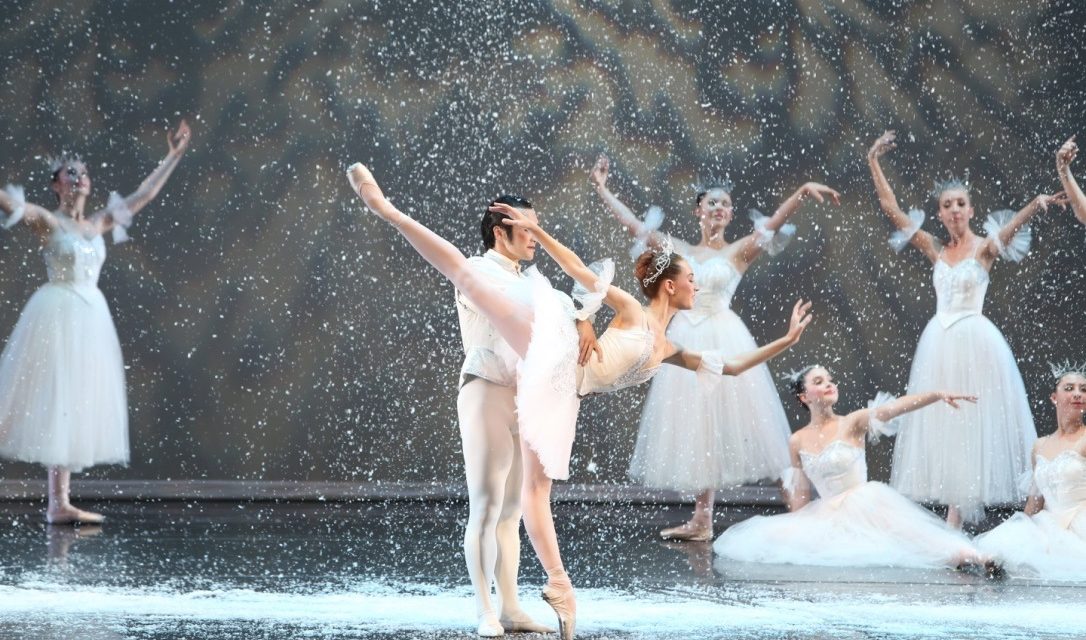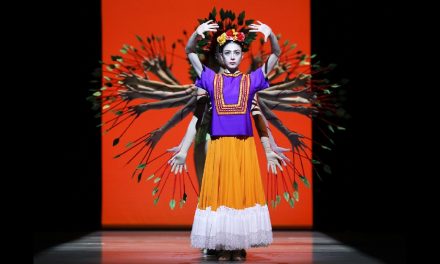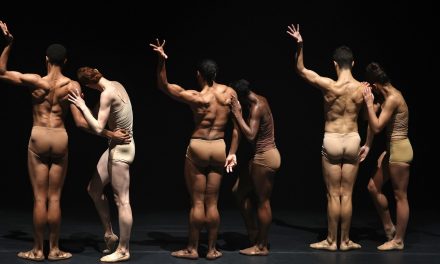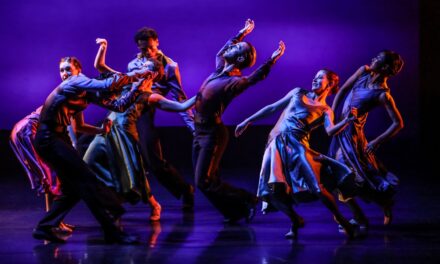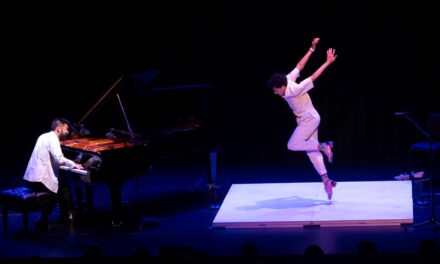It’s that time of the year again—evergreens, bright lights, terrible fruit cake and questions from your kids wondering what square-jawed, little wooden soldiers have to do with Christmas. Few yuletide traditions are more classic than Tchaikovsky’s Nutcracker, which is why there are currently dozens of ballet companies from major cities all over the country flooding LA right now for a chance to show off their version of the now over 125-year-old show.
For the uninitiated, the basic premise of The Nutcracker, which first premiered in Saint Petersburg in 1892, is that of a young, German girl named Clara Silberhaus whose favorite toy, a Christmas nutcracker given to her by Dr. Drosselmeyer, comes to life, fights and defeats a rat king and whisks her away to The Land of Sweets where her participation in his victory is venerated with a parade of dancing desserts representing different countries around the world. Though many roll their eyes at the tale’s juvenile plot and over-saturated presentations (Disney’s newest, poorly reviewed film isn’t helping), it’s a charming bedtime story come to life and one of a short list of historical dance shows children are welcome to enjoy.
Although New York (Balanchine’s hometown) and Russia (Tchaikovsky’s motherland) are usually the reigning kings of the Sugarplum Fairy–centered treat, I feel it might be time to pay closer attention to my home turf. Especially knowing that the famous ballet is the official money-maker for most dance companies, who then use the funds to create more innovative shows throughout the following year. After what has become a fabulous year of dance for Los Angeles, why not usher in a little more support in hopes of giving the city an even bigger reason to celebrate the new year? This season, I’d like to take a good look at the many (mostly professional) Los Angeles county–based companies putting on their version of the holiday staple.
First up on my list is the oldest and probably truest version within this SoCal lineup: Westside Ballet, whose production I saw on December 1 to kickstart my holiday spirit as soon as possible. Hailing from Santa Monica, this company has been presenting the ballet since 1973, with a classic choreographed version by their late founders Yvonne Mounsey and Rosemary Valaire. Performing for the sixth year in a row at The Broad Stage, Westside’s Nutcracker is accompanied by Santa Monica College’s Symphony Orchestra, which helps bring the standout soundtrack a life of its own. Though live music is ideal for dance performances of any kind, in this case, the melody’s vibrancy competed with certain key scenes.
Once the curtain rises, we are almost immediately introduced to Drosselmeyer, listed as Clara’s (Catia Boucher) godfather in this version, and played by Antonio Lopez, who shines as the mysterious clock-and-toymaker with something strange and interesting up his sleeve. His stern looks, cape and mustache give him the appearance of a Gothic villain, which helps the audience to slightly distrust him and his antics. His more dynamic performance adds the touch of darkness necessary to help balance such a saccharine production. He and his nephew (Gregory Maddela)’s late, highly anticipated arrival to the Silberhaus Christmas Eve party livens up the typically less exciting Act I (a quality that inevitably persists within every Nutcracker production), but not enough. Although one of the many characteristics of this production is its inclusion of 90 children, including understudies, who play various roles within the ballet, the already–family friendly show loses some of its already-soft edge. The little tikes’ parade at the beginning especially is very cute, but a little dull for those of us not searching to see the face of our own or our friends’ kids within the production.
There isn’t enough dancing to balance out some of the chaos caused by the much younger cast members’ scrambling around the stages in between moments of structured choreography. Briefly adding some pizzazz to this first half were solos by Daniella Zhou and long time company member Zane Tahvildaran Jesswein as the life-sized dancing doll and toy soldiers. Both dances are full of quick turns and artful leaps that respect their characters’ mechanical movements, but with enough airy springiness to avoid appearing rigid and graceless. Their performances, Jesswein’s in particular, left me wishing their segments were longer. The rest is mostly forgettable. That is of course, until the final scene when Clara climbs out of bed, finds her way down to where she had left her beloved toy behind and finds a mischief of rats taking over her living room.
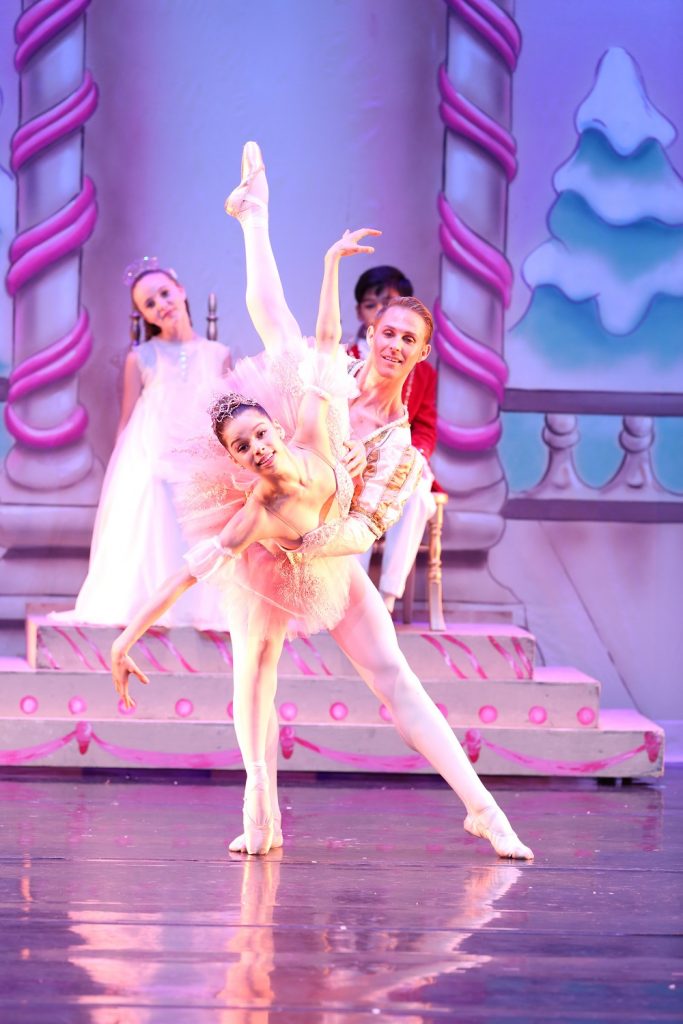
Westside Ballet’s The Nutcracker – Mirabelle Weinbach as the Sugar Plum Fairy with Evan Swenson – Photo by Todd Lechtick
Clara is transported into another realm where the rats are fighting an army of soldiers with her now–life sized nutcracker leading the way as their general. Because the rats and toy soldiers are also played by children, there is a similar helter-skelter vibe to their battle, which doesn’t allow for much cohesion. However, the staging is still rather cute and does manage to rely on its adorableness to dodge this drawback thanks to their use of exploding toy cannons. One thing that is clearly seen is Clara’s integral role in distracting the Rat King (Stefan Goy) long enough for her nutcracker to defeat him. The background is lifted and all else fades away as the nutcracker stands off to a corner and becomes engulfed in thick, white smoke. Suddenly, his toy head disappears, and he becomes a real boy. In this ballet specifically, he is played by Drosselmeyer’s nephew—an unsurprising Balanchine touch most likely inspired from Mounsey’s background as one of the great choreographer’s principal dancers—which does a better job of tying in the Christmas Eve party with the rest of Clara’s adventure.
Much like Drosselmeyer, his nephew is a quiet, but regal character—a more difficult trait for a kid to pull off. The downside, however, is that this also makes him seem removed from much of the rest of the show and indicates a lack of warmth toward Clara who immediately adores him. This is especially evident as he leads her through The Land of Snow on their way to The Land of Sweets. His face may look bored, but that’s where the ballet’s real fun begins.
Westside Ballet’s Nutcracker is interesting for its inclusion of characters such as the the Snow Queen (Isabella Cotrone) and Cavalier (guest artist Daniel Wagner), which other versions par down to a single soloist or fairy per dance portion. Here, the couple add a hint of adult charm. Their light-hearted pas de deux is a whimsy and light-hearted introduction to the upcoming second act. Both are skillful performers whose interlacing duet eclipsed a little bit of Wagner’s role within the ballet, but did wonders for the up-and-coming Cotrone whose poise and control was engaging. Moments later, the rest of the sixteen snowflakes expand upon the ballet’s childlike approach to the dancing and perform a frolic-y routine that begins with several controlled pirouettes at the spike of each flute, but becomes more erratic with plenty of skipping reminiscent of a light snowfall tousling in the wind. The troupe honed in their movements when forming two counter-moving circles of tiptoeing and gentle arm-rotating, their costumes glistening in the light. Cotrone’s slightly airier counterpart, Piper Everly, provided a nice transition through the ending of the scene by bringing in the crown the Snow Queen placed on Clara’s head before she and the Nutcracker Prince sleighed away.
During Act II, a group of angels announce their arrival with fake trumpets and an endearing romp before Mirabelle Weinbach appears in the ever-coveted role as the Sugarplum Fairy. After the Nutcracker Prince acts out the results of the battle (a charming callback to the early miming days of ballet prevalent during The Nutcracker’s original choreographers, Marius Petipa and Lev Ivanov’s, time). The beginning looks unclear, but once the rats enter the conversation, the silent dialogue becomes immediately recognizable, Clara is congratulated, and dessert is served.
The Fairy’s subjects include Spanish Chocolate, Arabian Coffee, Crystal Bells, Chinese Tea, Marzipan, Mother Ginger with her Polichinelles, Peppermint Candy and an unspecified Russian treat. The standout performances undoubtedly come from Chocolate, Coffee and the annually anticipated Russian dancers who never fail to trigger a rhythmic clap-along from the crowd as their music has transcended into Hollywood’s go-to Christmas film lure.
Cotrone and Jesswein are perfectly in sync, delivering one of the best performances of the entire ballet as a dynamic duo whose quick turns and lifts showcase variety in Cotrone’s range of movement and carries Jesswein’s previously established reputation as an entertaining dancer through this second performance. Arabia takes the cake as the sexiest couple to watch, quickly escalating Westside’s Nutcracker into adult territory. Rather than performing with an entourage as almost all the rest of the sweets do, these two thrive all on their own. Polite is the more charming of the two, but their constant lifts, intense eye contact and graceful extensions enhance the music’s suggestiveness, flipping the formula established by the rest of the ballet. It never seems to feel fully appropriate for an otherwise PG-13 ballet, but also manages to garner almost as much applause as the Russian section and Grand Pas Deux because of its enchantment and beauty.
Chinese Tea always manages to steer The Nutcracker into a bit of trouble. The music, dancing and costumes always seem problematic, which is why some productions have chosen to nix this part altogether, replacing the routine with another dance. However, there is something to be said for Westside’s decision to push forward and feature it anyway to honor the original work. Seeing as it is 2018 though, it is difficult to accept the racist undertones present, which always leaves me with a sour taste in my mouth, no matter how well it is performed. This production was no exception, especially with the kids bouncing up and down while making the “V” victory sign with their fingers—a move I haven’t quite figured out yet, but definitely feel strangely about.
Russia’s catapulting onto the stage is usually the hands-down crowd favorite and Johnny Zhong’s performance was no exception. Each catapulting turn and twirl left him the unchallenged star of the second act and while the rest of his group did a phenomenal job keeping up, his charisma and speed brought the crowd back to life out of its sweet food coma induced from watching the overly adorable Polichinelles pop out of Mother Ginger’s (Celeste Amos) body/house and the Marzipan quartet pay a low-key, but well-executed tribute to Italy.
Before fully being allowed to digest, the Waltz of the Flowers kicks off the next section with a routine that moves more quickly than that of The Land of Snow, but just as delicately. A group of dancers emerge with large half-wreaths of flowers in their hands as the music rises. Much of their crisscrossing involves waving the wreaths around in the air in circles above their head before bowing them forward. Nice and simple, the star of this section is the Dew Drop Fairy (Maya Zeevi) who makes her way to the middle before she is covered by the wreaths, then emerging between them like fresh rain. The flowers float around her as she performs her piece en pointe—with plenty of small hops, quick pirouettes and passes as she enters and exits the stage.
The most anticipated moment for ballet fans of all kind is the Grand Pas de Deux performed by the Sugarplum Fairy and her Cavalier, guest star Evan Swenson. Westside Ballet’s performance was everything you could hope for in a dance that helps form part of a grand finale. Weinbach is masterful as the prima ballerina, embracing her role with a confident smile reflected in her every movement. Swenson is also airy and light-footed but does shine as brightly when coupled with Weinbach. This may in no small part be due to company’s staging of the play. The Cavaliers, who don’t even have a name, are undermined thanks to the emphasis on the fairies, especially Sugarplum, within whom Clara is supposed to see a reflection of the adult version of herself. On his own, Swenson executes each and every pirouette with ease and control, but when supporting Weinbach, it is clear that she is the star. The only part that counters this notion are their lifts. They are grandiose more so than romantic but add the sense of magnificence no Grand Pas de Deux should be without.
The Sugarplum Fairy’s following solo is a bit less magical, but Weinbach glows in it just the same. Though brief, her bourrées reflect the twinkling of a dream, the final indication that Clara may be dreaming, but which Westside purposely leaves ambiguous. After a short recap in which all of the worldly sweets come out to bid one final farewell to Clara, a confetti cannon goes off as she hops in her sleigh and the Nutcracker Prince escorts her off stage.
Overall, Westside’s charming piece is everything one would expect from a ballet geared toward children. Every moment is tender and although some of it may border on tedious for the adults, the choreography, along with Nancy Drake and Liz Wasynczuk’s beautifully colorful costumes, and Jennifer Dorame and Adrienne Kinsella’s hand-painted backdrops create an atmosphere impossible not to smile at.
For more information on the Westside Ballet, click here.
Featured image: Westside Ballet’s The Nutcracker – Renée Spaltenstein as the Snow Queen – Photo courtesy of the company.

